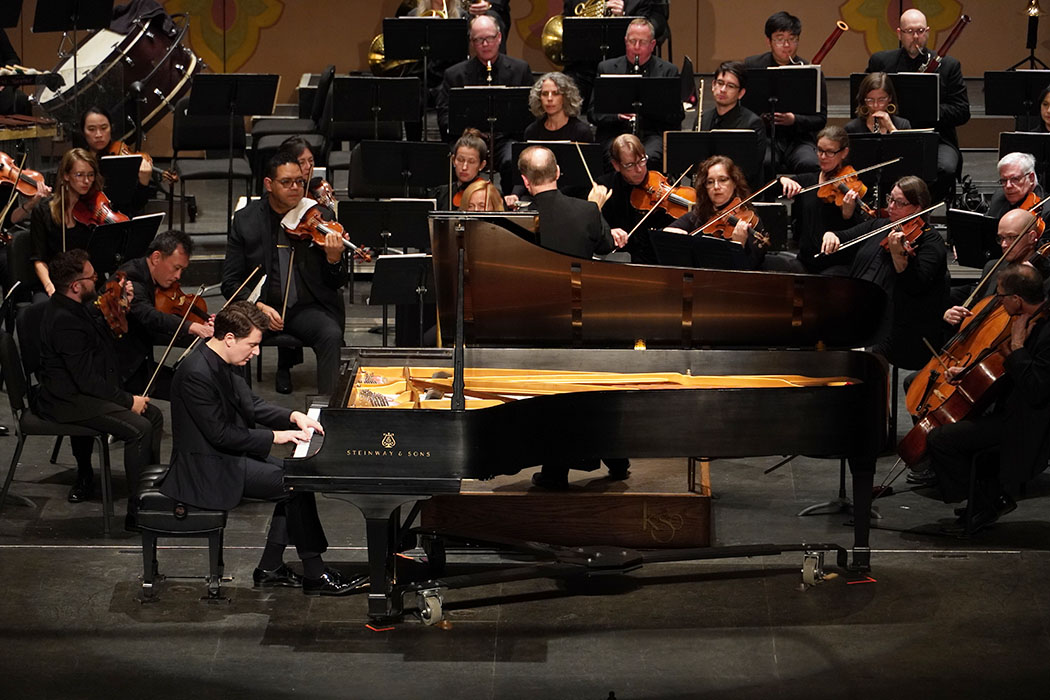For a brief instant, the pose caught me by surprise but seemed unmistakable. Pianist Alessio Bax had just brought the house down in a performance of Rachmaninoff’s Piano Concerto No. 3 with the Knoxville Symphony Orchestra and was taking bows, accepting the loud and continuous applause from the audience. And then, there it was, the snapshot—Bax reached out his left hand and grasped the corner of the piano with a particular posture. Whether an unconscious gesture, or a deliberate one, Bax was paying homage to the composer and first performer of the “Rach Three.” That pose is immortalized in bronze and is a feature of the statue of Rachmaninoff that resides in a corner of World’s Fair Park.

In many ways, the “Rach Three” is the ultimate statement of Rachmaninoff’s art and craft, offering a combination of achingly beautiful, romantic melodies, richly spacious orchestrations, and a piano line that is notorious for requiring playing stamina and virtuosic technical ability. On any other evening, a stunning performance of the work would be quite enough. On this occasion, however, there was more to talk about. KSO Resident Conductor James Fellenbaum was on the podium, standing in for Maestro Aram Demirjian who was taking the week off to be with wife Caraline and new daughter, Ani, following her birth last weekend.
Bax and Fellenbaum were in agreement on the nicely brisk and flexible tempos throughout that were neither staid nor extreme. Some believe that one can judge the interpretative direction of the concerto by how the pianist takes the opening lyrical theme. In Friday evening’s performance, Bax took that theme with a subtle and gentle touch of character, leaving room for the ensuing drama—percussive octave statements and delicate, crystalline runs, that give way later to a judiciously applied rubato in the lyrical passages, and in the cadenza.
Bax continued the middle Intermezzo movement building moments of expressive character into his overall premise. The Finale was exactly what one expects and hopes for—a crescendo of emotion through sweeping lyricism—then virtuosic acrobatics that culminated in octave runs of breathless energy at seemingly impossible speed—into an ending that pulled the audience to their feet for a lengthy show of appreciation. Kudos also go to Fellenbaum and the KSO strings for tight ensemble playing that was sensitive and lush—an essential contributor to the concerto’s emotional strength.

Interestingly, a lot of the pre-concert anticipation was for the work on the first half of the program, Charles Ives Symphony No. 2. Although first performed in 1951 by Leonard Bernstein and the New York Philharmonic, the symphony was written some 50 years earlier and represented a young composer that was mixing European-esque Romantic tradition with his own developing style of borrowed Americana. Maestro Fellenbaum—as Demirjian surely would have done as well—took time to preface the details of the work for the audience, most of whom were hearing it for the first time.
Although later works gave Ives the reputation for cacophony and multi-tonal dissonance, the five-movement Second Symphony was a delightful two-pronged journey for the KSO players—European Romantic era solidity, interwoven with suggestions of gospel tunes, hymns, and popular songs often inserted and flavored by the woodwinds. These Americana items emerge from the background, then recede back into sonic mist—“Bringing in the Sheaves,” “Camptown Races,” and Samuel A. Ward’s tune that was interpolated into “America the Beautiful” among others.
Having teased with “Columbia, Gem of the Ocean” since the first movement, Ives eventually allows the trombones in the Finale to complete the quotation, even if the trumpets are suggesting the abolitionist song “Wake Nicodemus.” And with Ives’ satiric wit, the symphony ends with an infamous explosive dissonance that leaves the audience with both a smile and a loving smirk.
Again, kudos go to Fellenbaum for a masterful stand-in performance with the orchestra, carrying off the complexity of the evening with accuracy, confidence, and a brilliant display of interpretative artistry. Knoxville is indeed lucky to have him.







